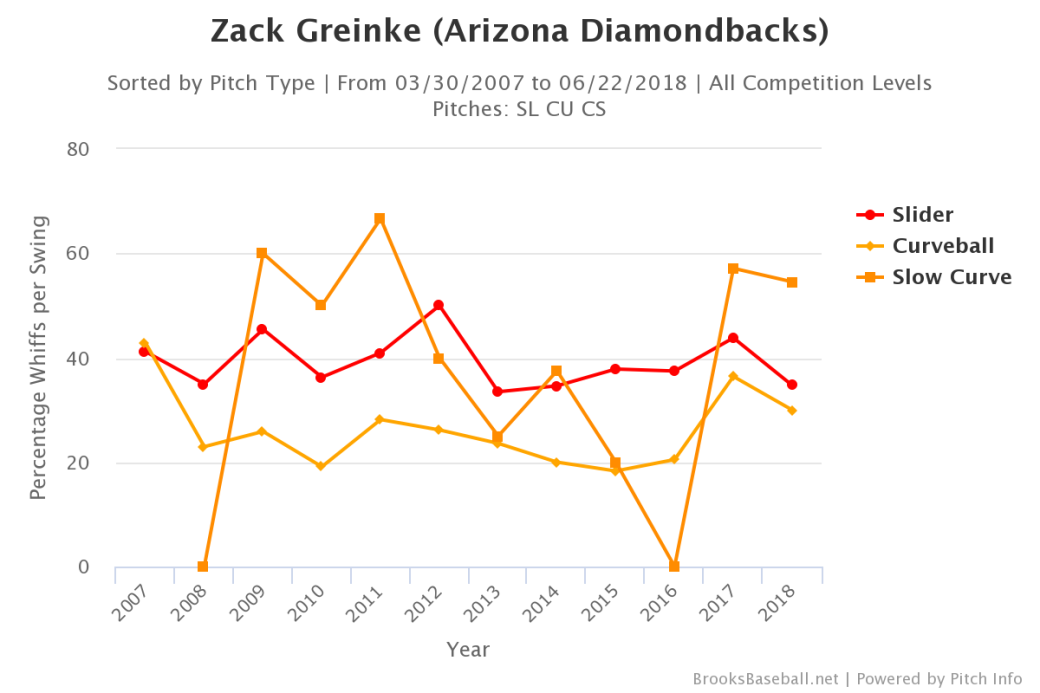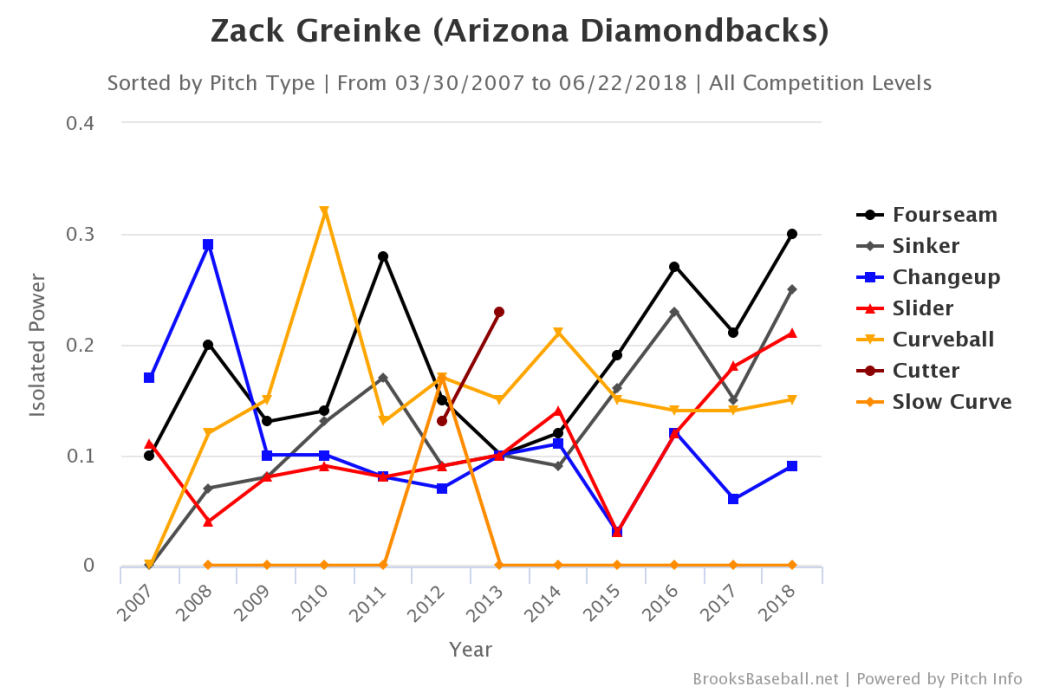A quick glance at Greinke’s stat line will give you the impression that he is having a very mediocre season. His ERA is sittting at 3.90, and his 3.99 FIP would show that this has been about what Zack deserves. If you are a die-hard traditionalist, the 6-5 record would support these metrics. It seems “meh,” which is not what you would like from a guy being paid 31 Million bucks to throw a sphere past a guy with a stick. With Greinke pitching in his age-34 season, is this simply the natural decline of an aging ace? Age does play a role in Greinke’s average results, but he is pitching far better than the surface stats would indicate.
A lot of Greinke’s underlying metrics are strangely similar to what they were in 2017. He’s getting the Ks at about the same rate, 25.6% this year compared to 26.8% last year, but he is giving up the free pass less, down half a percent to 5.1. The opposing batters’ plate discipline paints a similar picture. Last season, hitters swung 34.4% of the time at pitches outside of the zone; this season, they are swinging…34.4% of the time at pitches outside of the zone. As a matter of fact, despite a small increase at swings inside the zone, hitters are swinging the same amount at Greinke’s offerings as they were in 2017 (45.9%). However, batters are making contact more often than in 2017, which has lead to a 1% drop in swinging strike rate and the corresponding decrease in raw K rate.
But there is something weird about the increased contact: it’s only on pitches outside of the strike zone. As a matter of fact, on pitches inside the zone, hitters are only making contact 82.5% of the time, down from 85.1% in 2017. However, on the pitches outside the zone, hitters are making contact 9% more often, which is a large increase. Therefore, hitters are still tempted by the pitches outside the zone, but they are making contact more often. This should indicate that the pitches that are intended to induce whiffs outside of the zone (the curve and slider, most notably) are generating less whiffs than before, and sure enough:

Greinke is getting less whiffs with his breaking balls than he did last year, but the new percentages are actually more in line with his career numbers. The contact rates, too, are not actually Greinke declining due to age, but his numbers reverting back to his career averages, which is to be expected. The contact on pitches outside the zone isn’t something to be overly concerned about. In addition, the movement on his pitches is quite similar to where it has been in the past. Overall, there has been regression in his contact rates, but nothing particularly concerning.
The batted ball data, however, flashes several warning lights. He’s getting ground balls 5% less, and that previously harmless contact is turning into more line drives (up 4%) and more fly balls (up 1%). (Some of those fly balls are infield pop ups, which he has induced 3% more often—as a function of fly ball percentage, rather than contact percentage). He is also allowing less soft and medium contact and is instead dishing out hard contact 8% more often. This time, regression is not the simple culprit; his 43.9% hard contact rate is easily a career high.
So, if Greinke is allowing more fly balls and more hard contact, then surely he must be allowing more home runs, right? Yes, and a bunch of them. His 1.60 HR/9 rate is the highest of his career, and he has already given up more dingers this season than he did with the Dodgers in twice as many starts in both 2015 and 2013. What pitch is the damage being done against? All of them, except the slow curve:

Every pitch is headed in the wrong direction, many of which are resulting in career high’s in extra-base hit damage. Most notably, the fastball is being lit up to an ISO of .304 compared to .210 last season. The reason for this is by no means a secret; Greinke’s velocity has once again declined, making each offering slightly more hittable. Reduced velo has lead to an increase in extra-base hits against him, and notably, a flurry of home runs. You can survive as a major-league pitcher throwing a fastball that barely hits 90 mph, but the margin of error is going to be reduced, and when he does make a mistake, the ball may fly a long way. So, the increase in home runs does seem to be somewhat merited.
But I promise you that this isn’t a sad story. His ERA is heavily inflated by the long balls, and FIP, which only takes into account strike outs, walks, and home runs, follows the same story line. xFIP, cFIP, and DRA, however, are far more complex statistics that are far better at predicting future performance than just FIP and ERA. His xFIP is at 3.38, only 0.04 runs higher than 2017. His cFIP is at 82, which is 18% better than a league average pitcher. DRA, while still predictive, also functions by determining how many runs a pitcher deserved to allow, and it is the most optimistic of all: 2.35, the lowest figure of his career bar his incredible 2015 season, with a standard deviation of 0.26 runs. That’s eighth in the league; Greinke is still a very good pitcher.
Our ace is getting older. He can’t ramp up his heater like he used to, and the margin of error is smaller than it used to be. Age has taken some things away from Zack. He’s given up too many home runs as a result, but when you look at the stat line and see an ERA in the upper 3s, remember that he is, and likely will be, pitching better than that. He’s not gonna win a Cy Young Award or put up a season like he did in 2015, but Greinke is still our ace.
Pingback: Snake Bytes 6/24: Sweep the Deck | VegasPicks.com